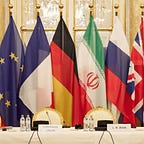OSINT from the Iranian Web: Following the Track to Niger
In early August 2023, while most of us were away from our computers, a coup was held in Niger where ruling President Mohamed Bazoum was overthrown by a military junta.
At first sight, it just looked like another coup out of many in the region made from the same recipe: poverty and inequalities, rising anti-Western feelings, corrupted law-enforcement forces, Russia meddling in at some point. This mix ended up in a military coup throwing away the elected President of a failing state. Nothing new here since the same had happened lately all around Africa.
Yet, Niger sounded different for one reason: uranium, the raw material needed to manufacture the most powerful weapon that mankind has ever created. Niger is the 7th producer of it worldwide as uranium mines were mainly exploited so far by France and a Niger-based company.
The position of France being shattered by the new junta, one could ask: who is going to fill the gap? Russia? China which is already exploiting some small mines in the country? Some OSINT research, which I’ll detail next, helped me found out that another well-known nuclear player had slowly stepped into the battle for Niger’s resources: Iran.
Being interested in everything related to Iran’s strategic activities, I decided to look closely at the Iranian web. I noticed that one of Iran’s main official sources of information, the Iranian Republic News Agency (IRNA), disclosed a meeting on the 25th of October 2023 in Tehran between Niger’s Prime Minister Bakary Yaou Sangare and his Iranian counterpart. A quick search on Wikipedia helped found out that Iran had already tried several times to get a hand on Niger’s uranium. In 1984, the Islamic Republic of Iran Broadcasting (the main radio of the regime) announced that Niamey and Tehran were close to clinch a deal on the purchase of uranium — a deal that eventually felt short from being even signed.
Going further through all the mentions of “Niger” on the English version of IRNA’s website, I found some pictures of a delegation led by Niger’s Prime Minister that flew to Tehran in order to sign several contracts on “economics, politics and health” matters on the 23rd of January 2024.
There was then no mention of uranium whatsoever. Curious about what these deals could really be about, I started to have a close look at the Iranian delegation through the use of Pimeyes. This powerful face-recognition tool identified several recurrent faces on the official pictures of IRNA so I started processing it one by one.
Searching through the web, PimEyes had a match for one of the faces: 237 results in just 2.06 seconds. It seemed like this person must have been important enough to be found quite easily. I thought at first that he might just be a minister or some kind of mid-range politician.
He’s actually more than that. Going through the mostly-Iranian sources of the pictures displayed by PimEyes (notice: you must pay for that), I found out that this person is no less than Mohamed Eslami, head of the Atomic Energy Organization of Iran (AEOI) or Sazman-e Energy-e Atomi in Persian.
Naming the main Iranian government agency in charge of nuclear technology research and development, including the undeclared activities at the suspicious facilities of Fordow and Natanz. Why was the leader of this peculiar organization standing at the front row of a deal signing if Iran
had no interest of developing a commercial relationship on uranium with Niger?
My findings were soon to be confirmed. On the 17th of March 2024, the Wall Street Journal revealed that some secret negotiations were happening behind closed doors between Iran and the new leaders of Niger. The latter denied it despite evidence of the contrary coming from Iranian easily-available sources. Of course, the US accusing a Middle-Eastern country of trying to secretly get uranium from an African country reminds some analysts of the chaotic road to 2003 events, when the United States
falsely accused Iraqi leader Saddam Hussein of trying to buy “yellowcake” from Niger for his own nuclear program. Sadly OSINT wasn’t so randomly used at the time.
This article is a simple demonstration of how you can establish links denied by governments using OSINT methodology and
proper tools.
Hoping you enjoyed this article, please follow me on Medium and X !
David O.
